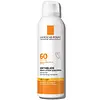What's inside
What's inside
 Key Ingredients
Key Ingredients

 Benefits
Benefits

 Concerns
Concerns

 Ingredients Side-by-side
Ingredients Side-by-side

Butyl Methoxydibenzoylmethane 2.68%
UV AbsorberHomosalate 9.6%
Skin ConditioningEthylhexyl Salicylate 2.88%
UV AbsorberOctocrylene 5.38%
UV AbsorberBenzophenone-3 3.46%
UV AbsorberWater
Skin ConditioningDimethicone
EmollientIsopropyl Lauroyl Sarcosinate
Skin ConditioningGlycerin
HumectantStyrene/Acrylates Copolymer
Isotridecyl Isononanoate
EmollientPolyurethane-35
Caprylyl Methicone
Skin ConditioningOctyldodecanol
EmollientPhenoxyethanol
PreservativePropylene Glycol
HumectantCaprylyl Glycol
EmollientSodium Stearoyl Glutamate
CleansingPolysorbate 61
EmulsifyingGlyceryl Stearate
EmollientPEG-8 Laurate
EmulsifyingDimethiconol
EmollientOctyldodecyl Xyloside
EmulsifyingPEG-12 Dimethicone
Skin ConditioningP-Anisic Acid
MaskingStearyl Alcohol
EmollientDisodium EDTA
Tocopherol
AntioxidantDiethylhexyl Syringylidenemalonate
Skin ProtectingCassia Alata Leaf Extract
AstringentMaltodextrin
AbsorbentButyl Methoxydibenzoylmethane 2.68%, Homosalate 9.6%, Ethylhexyl Salicylate 2.88%, Octocrylene 5.38%, Benzophenone-3 3.46%, Water, Dimethicone, Isopropyl Lauroyl Sarcosinate, Glycerin, Styrene/Acrylates Copolymer, Isotridecyl Isononanoate, Polyurethane-35, Caprylyl Methicone, Octyldodecanol, Phenoxyethanol, Propylene Glycol, Caprylyl Glycol, Sodium Stearoyl Glutamate, Polysorbate 61, Glyceryl Stearate, PEG-8 Laurate, Dimethiconol, Octyldodecyl Xyloside, PEG-12 Dimethicone, P-Anisic Acid, Stearyl Alcohol, Disodium EDTA, Tocopherol, Diethylhexyl Syringylidenemalonate, Cassia Alata Leaf Extract, Maltodextrin
Water
Skin ConditioningEthylhexyl Methoxycinnamate
UV AbsorberIsododecane
EmollientGlycerin
HumectantCyclopentasiloxane
EmollientHomosalate
Skin ConditioningPolymethylsilsesquioxane
Methylene Bis-Benzotriazolyl Tetramethylbutylphenol
UV FilterOctyldodecanol
EmollientDiethylamino Hydroxybenzoyl Hexyl Benzoate
UV FilterEthylhexyl Triazone
UV AbsorberHydroxyethyl Acrylate/Sodium Acryloyldimethyl Taurate Copolymer
Emulsion StabilisingOctyldodecyl Xyloside
EmulsifyingPEG-30 Dipolyhydroxystearate
EmulsifyingBis-Ethylhexyloxyphenol Methoxyphenyl Triazine
Skin ConditioningPhenoxyethanol
PreservativeDecyl Glucoside
CleansingHydroxyacetophenone
AntioxidantPolyisobutene
Trimethylsiloxysilicate
EmollientPEG-7 Trimethylolpropane Coconut Ether
EmulsifyingDisodium EDTA
Sorbitan Isostearate
EmulsifyingXanthan Gum
EmulsifyingCaprylic/Capric Triglyceride
MaskingPropylene Glycol
HumectantXylose
HumectantEctoin
Skin ConditioningMagnesium Ascorbyl Phosphate
AntioxidantSodium Hyaluronate
HumectantTocopheryl Acetate
AntioxidantLaminaria Ochroleuca Extract
Skin ConditioningWater, Ethylhexyl Methoxycinnamate, Isododecane, Glycerin, Cyclopentasiloxane, Homosalate, Polymethylsilsesquioxane, Methylene Bis-Benzotriazolyl Tetramethylbutylphenol, Octyldodecanol, Diethylamino Hydroxybenzoyl Hexyl Benzoate, Ethylhexyl Triazone, Hydroxyethyl Acrylate/Sodium Acryloyldimethyl Taurate Copolymer, Octyldodecyl Xyloside, PEG-30 Dipolyhydroxystearate, Bis-Ethylhexyloxyphenol Methoxyphenyl Triazine, Phenoxyethanol, Decyl Glucoside, Hydroxyacetophenone, Polyisobutene, Trimethylsiloxysilicate, PEG-7 Trimethylolpropane Coconut Ether, Disodium EDTA, Sorbitan Isostearate, Xanthan Gum, Caprylic/Capric Triglyceride, Propylene Glycol, Xylose, Ectoin, Magnesium Ascorbyl Phosphate, Sodium Hyaluronate, Tocopheryl Acetate, Laminaria Ochroleuca Extract
 Reviews
Reviews

Ingredients Explained
These ingredients are found in both products.
Ingredients higher up in an ingredient list are typically present in a larger amount.
Disodium EDTA plays a role in making products more stable by aiding other preservatives.
It is a chelating agent, meaning it neutralizes metal ions that may be found in a product.
Disodium EDTA is a salt of edetic acid and is found to be safe in cosmetic ingredients.
Learn more about Disodium EDTAGlycerin is already naturally found in your skin. It helps moisturize and protect your skin.
A study from 2016 found glycerin to be more effective as a humectant than AHAs and hyaluronic acid.
As a humectant, it helps the skin stay hydrated by pulling moisture to your skin. The low molecular weight of glycerin allows it to pull moisture into the deeper layers of your skin.
Hydrated skin improves your skin barrier; Your skin barrier helps protect against irritants and bacteria.
Glycerin has also been found to have antimicrobial and antiviral properties. Due to these properties, glycerin is often used in wound and burn treatments.
In cosmetics, glycerin is usually derived from plants such as soybean or palm. However, it can also be sourced from animals, such as tallow or animal fat.
This ingredient is organic, colorless, odorless, and non-toxic.
Glycerin is the name for this ingredient in American English. British English uses Glycerol/Glycerine.
Learn more about GlycerinHomosalate is a chemical sunscreen filter that provides protection in the UV-B range (280nm - 320 nm), with a peak protection at 306 nm. It is internationally approved for use in sunscreens.
Homosalate is not photo-stable, meaning it's strength as a UV filter degrades over time with exposure to the sun. Because of this, it's often used in combination with other chemical sunscreen filters as avobenzone (which protects from the UV-A range). Homosalate also helps act as a solvent for harder-to-dissolve UV filters.
(Part of the reason that sunscreens need to be frequently re-applied is due to the photo instability of many chemical sunscreen filters)
Currently, homosalate is approved in concentrations up to 10% in the EU and 15% in the US. The FDA is currently doing further research on the effects of homosalate, and it is possible that these approved concentrations will change in the future.
Learn more about HomosalateOctyldodecanol is a fatty alcohol. It is primarily used to enhance the texture of products.
As an emulsifier, Octyldodecanol helps prevent the oils and waters from separating. It also prevents ingredients from creating foam when shaken.
Octyldodecanol is created by reducing fatty acid to an alcohol.
Due to its high molecular weight, it does not get absorbed into the skin.
Learn more about OctyldodecanolWe don't have a description for Octyldodecyl Xyloside yet.
Phenoxyethanol is a preservative that has germicide, antimicrobial, and aromatic properties. Studies show that phenoxyethanol can prevent microbial growth. By itself, it has a scent that is similar to that of a rose.
It's often used in formulations along with Caprylyl Glycol to preserve the shelf life of products.
Propylene Glycol is an odorless, colorless liquid. As a humectant, it helps skin retain moisture. It also aids in delivering active ingredients.
Another role of this ingredient is preventing a product from melting or freezing. Propylene glycol also adds antimicrobrial properties to a product, elongating product lifespan.
This ingredient is considered an organic alcohol and commonly added into both cosmetics and foods.
Those with sensitive skin or conditions may develop a rash when using this ingredient.
Learn more about Propylene GlycolWater. It's the most common cosmetic ingredient of all. You'll usually see it at the top of ingredient lists, meaning that it makes up the largest part of the product.
So why is it so popular? Water most often acts as a solvent - this means that it helps dissolve other ingredients into the formulation.
You'll also recognize water as that liquid we all need to stay alive. If you see this, drink a glass of water. Stay hydrated!
Learn more about Water